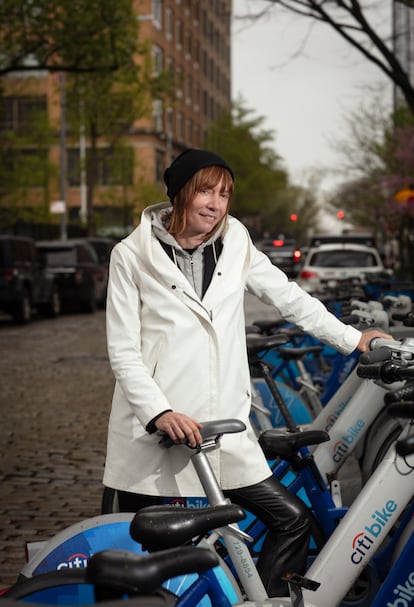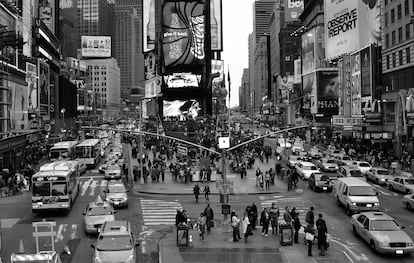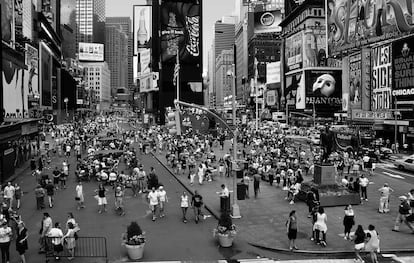The woman who led the transformation of New York into a pedestrian-friendly city
Between 2007 and 2013, Janette Sadik-Khan was the city’s transportation commissioner, creating a bike rental system and closing Times Square to traffic. A decade later, she has published a book and remains committed to making cities more livable places

Yesterday, just like today, Janette Sadik-Khan, 63, rode her bike to work as director of Bloomberg Associates, a philanthropic consultancy for the improvement of urban spaces. Tomorrow, the former New York transportation commissioner between 2007 and 2013 will once again use Citi Bike, a bicycle sharing program that she herself inaugurated during her last year in the post. “Yesterday there were 143,000 of us who used the system in the city!” she announces with enormous effusiveness in a video call (without video) on a hot afternoon in late April. The project started with 600 stations and about 3,300 bicycles. It now has 2,613 stations and 36,280 bicycles.
“It will never work. It’s too cold in New York. It’s too hot in New York. New York is too dangerous. New York is too New York...” Sadik-Khan remembers with a laugh all the bad omens that predicted failure for her project to provide the city with a system that had been operating in Barcelona (Bicing) or Paris (Vélib) for about six years. This story of urban transformation and others that took place in New York but also in Rio de Janeiro, Auckland and Toronto make up Street Fight, a book written with her collaborator and chief media strategist Seth Solomonow, in which they explain the nature and implementation process of many of the most relevant changes that cities have experienced in the last two decades. Using before-and-after photos and images of protests to illustrate the explanations, the book covers everything from super city blocks to tactical urbanism, and how the Covid-19 pandemic led to converting 10,000 parking spaces in New York into sidewalk terraces for bars and restaurants. “The pandemic helped us remember that we must reclaim the streets,” she says.


What has defined Sadik-Khan’s work to date has been her bold attitude. While it is true that some of the transformations that she led in New York under then-mayor Michael Bloomberg were already in operation in other capitals, the speed and determination with which she put them into practice is unparalleled. “You have to move quickly, because people don’t believe that cities can change. If you show them what can happen, even if it is by using tactical urbanism, painting a street one night, the city mutates, it becomes something else. It reduces anxiety about change. And the fact of it being temporary makes people relax. It is understood that little has been invested, and perhaps that makes the perception of change less than it really is,” says this political science graduate of Occidental College in Los Angeles. It is also important to move on a smaller scale. The book offers various examples of small interventions, such as in Pearl Street Triangle, in the Dumbo neighborhood of Brooklyn, where a triangular parking space was converted into a small park that can be called a plaza. “This helps you see what could be achieved.”
The work of pedestrianizing streets and eliminating parking spaces, which may sound objectively positive, has faced open opposition from citizens and the political establishment every time it has been tried in almost any city in the world. There are people who are even bothered by flowerbeds. After two decades dedicated to making cities a better place to live, Sadik-Khan has understood that her responsibility “is not to avoid controversies, but to lead transformative projects.” “You have to be ambitious. And able to show the economic benefits, because, in most cases, the data supports us. With these we must confront those who say that pedestrianization is bad for retail sales, or discredit those who feel that a superblock prevents ambulances from entering,” she notes about the reluctance shown towards this type of project. It has been said that the 15-minute city is a ghetto designed by governments to keep us under control.
Sadik-Khan’s great enemy is the car. She claims to be tired of a century of cities built for cars. “I want the human being to be at least as important in the city as the car,” jokes the former vice president of the consulting firm Parsons Brinckerhoff. “The point is that, in the end, a car is a car,” she insists. “I don’t care if it is self-driving, electric... It occupies the same space, a space that is not its own.” After all, cities existed before cars.
The problem arises not when the city was built long before the arrival of the vehicle, but almost at the same time, as is the case in many American cities. So, the process is not one of demanding the return of the streets to pedestrians, but rather the transformation required is much deeper, longer, and more expensive. Humanizing Milan or Valencia is not the same as Phoenix or Houston. “But it’s not impossible. It is true that it is necessary to create areas with greater density to be able to articulate a different transportation system.” Los Angeles could be an example of how you can bet on this type of change in a place that was built only with the car in mind, where there are streets without sidewalks, and where until recently walking was a suspicious activity. Los Angeles opted for density, both by building huge condominiums and by developing groups of five or six-story buildings with green areas and bike lanes. “In recent years, Los Angeles has invested more in public transportation than New York.”
One of her most celebrated interventions took place in Times Square, probably what until then was one of the busiest and at the same time least pedestrian-friendly spaces in the world. She cut off traffic, paved, and placed tables and chairs, taking advantage, it must also be said, that the area was no longer a dangerous place like it was in the 1970s. “Even though it is a tourist area, you never do this thinking about the tourist. Everything you undertake in the city should only be done with residents in mind,” she points out.
The fact that these changes have been undertaken in large cities such as Milan or Paris and in emblematic places such as Times Square may lead one to think that this is an exclusive deal for large cities, with their million-dollar budgets, their brand spirit, and their media impact. “No!” says Sadik-Khan. “All cities are transformable. Everyone can do it.”
Sign up for our weekly newsletter to get more English-language news coverage from EL PAÍS USA Edition
Tu suscripción se está usando en otro dispositivo
¿Quieres añadir otro usuario a tu suscripción?
Si continúas leyendo en este dispositivo, no se podrá leer en el otro.
FlechaTu suscripción se está usando en otro dispositivo y solo puedes acceder a EL PAÍS desde un dispositivo a la vez.
Si quieres compartir tu cuenta, cambia tu suscripción a la modalidad Premium, así podrás añadir otro usuario. Cada uno accederá con su propia cuenta de email, lo que os permitirá personalizar vuestra experiencia en EL PAÍS.
¿Tienes una suscripción de empresa? Accede aquí para contratar más cuentas.
En el caso de no saber quién está usando tu cuenta, te recomendamos cambiar tu contraseña aquí.
Si decides continuar compartiendo tu cuenta, este mensaje se mostrará en tu dispositivo y en el de la otra persona que está usando tu cuenta de forma indefinida, afectando a tu experiencia de lectura. Puedes consultar aquí los términos y condiciones de la suscripción digital.
More information
Archived In
Últimas noticias
The life of a delivery driver in China: ‘Many people don’t know how an order can arrive at their home in just one day’
Maude Apatow, from acting in ‘Euphoria’ to directing: ‘There are many films that you can tell weren’t written by someone young’
Can cheese protect brain health? This is what the science says
Helen Levitt, the photographer who captured the theater of the everyday
Most viewed
- Christian Louboutin: ‘Young people don’t want to be like their parents. And if their parents wear sneakers, they’re going to look for something else’
- US sanctions against jailed cartel leader ‘El Marro’ highlight Mexico’s lack of control over its prisons
- Cartels in Mexico take a leap forward with narco-drones: ‘It is criminal groups that are leading the innovation race’
- Liset Menéndez de la Prida, neuroscientist: ‘It’s not normal to constantly seek pleasure; it’s important to be bored, to be calm’
- ‘El Limones’ and the growing union disguise of Mexican organized crime











































